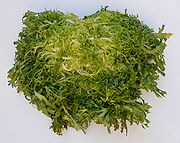
Endive
Encyclopedia
Endive Cichorium endivia, is a leaf vegetable
belonging to the daisy family
. Endive can be cooked or used raw in salad
s.
(Cichorium intybus). There is considerable confusion between Cichorium endivia and Cichorium intybus.
Endive belongs to the chicory genus
, which includes several similar bitter leafed vegetables. Species include endive (Cichorium endivia), Cichorium pumilum
and common chicory (Cichorium intybus). Common chicory includes chicory types such as radicchio
, puntarelle and Belgian endive.
Endive is rich in many vitamins and minerals, especially in folate and vitamins A
and K
, and is high in fiber
.
There are two main varieties of cultivated endive:

Leaf vegetable
Leaf vegetables, also called potherbs, green vegetables, greens, leafy greens or salad greens, are plant leaves eaten as a vegetable, sometimes accompanied by tender petioles and shoots...
belonging to the daisy family
Asteraceae
The Asteraceae or Compositae , is an exceedingly large and widespread family of vascular plants. The group has more than 22,750 currently accepted species, spread across 1620 genera and 12 subfamilies...
. Endive can be cooked or used raw in salad
Salad
Salad is any of a wide variety of dishes, including vegetable salads; salads of pasta, legumes, eggs, or grains; mixed salads incorporating meat, poultry, or seafood; and fruit salads. They may include a mixture of cold and hot, often including raw vegetables or fruits.Green salads include leaf...
s.
Background
Endive is also a common name for some types of chicoryChicory
Common chicory, Cichorium intybus, is a somewhat woody, perennial herbaceous plant usually with bright blue flowers, rarely white or pink. Various varieties are cultivated for salad leaves, chicons , or for roots , which are baked, ground, and used as a coffee substitute and additive. It is also...
(Cichorium intybus). There is considerable confusion between Cichorium endivia and Cichorium intybus.
Endive belongs to the chicory genus
Cichorium
Cichorium is a genus of flowering plants in the family Asteraceae. The species are commonly known as chicory or endive – there are two cultivated species, and four to six wild species....
, which includes several similar bitter leafed vegetables. Species include endive (Cichorium endivia), Cichorium pumilum
Cichorium pumilum
Cichorium pumilum ' is a species of plant in the Asteraceae family. Like the two other species of Cichorium, its leaves are edible, it produces bluish-violet flowers, and its roots are carrotlike, much like Apiaceae roots....
and common chicory (Cichorium intybus). Common chicory includes chicory types such as radicchio
Radicchio
Radicchio is a leaf chicory , sometimes known as Italian chicory and is a perennial. It is grown as a leaf vegetable which usually has white-veined red leaves. It has a bitter and spicy taste, which mellows when it is grilled or roasted.- History :Humans have been using radicchio since ancient times...
, puntarelle and Belgian endive.
Endive is rich in many vitamins and minerals, especially in folate and vitamins A
Vitamin A
Vitamin A is a vitamin that is needed by the retina of the eye in the form of a specific metabolite, the light-absorbing molecule retinal, that is necessary for both low-light and color vision...
and K
Vitamin K
Vitamin K is a group of structurally similar, fat soluble vitamins that are needed for the posttranslational modification of certain proteins required for blood coagulation and in metabolic pathways in bone and other tissue. They are 2-methyl-1,4-naphthoquinone derivatives...
, and is high in fiber
Fiber
Fiber is a class of materials that are continuous filaments or are in discrete elongated pieces, similar to lengths of thread.They are very important in the biology of both plants and animals, for holding tissues together....
.
There are two main varieties of cultivated endive:

- Curly endive, or frisée (var crispum). This type has narrow, green, curly outer leaves. It is sometimes called chicory in the United StatesUnited StatesThe United States of America is a federal constitutional republic comprising fifty states and a federal district...
and is called chicorée frisée in French. Further confusion results from the fact that frisée also refers to a technique in which greens are lightly wilted with oil.
- Escarole, or broad-leaved endive (var latifolia) has broad, pale green leaves and is less bitter than the other varieties. Varieties or names include broad-leaved endive, Bavarian endive, Batavian endive, grumolo, scarola, and scarole. It is eaten like other greens, sauteed, chopped into soups and stews, or as part of a green salad.
External links
- Belgian Endive Official Resource Page for Belgian Endive
- Endive and Chicory
- Frisée

